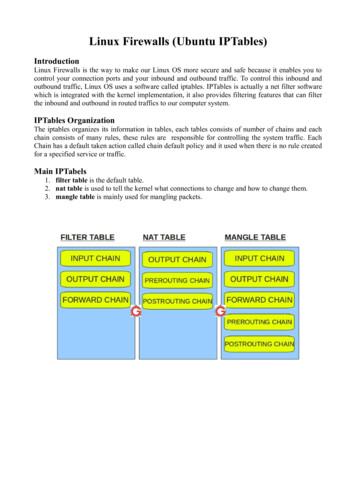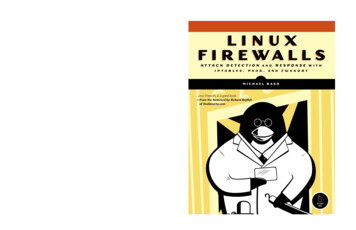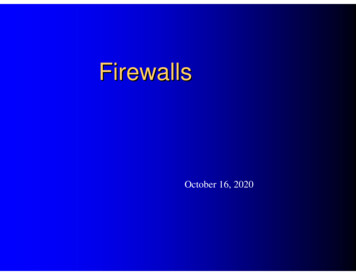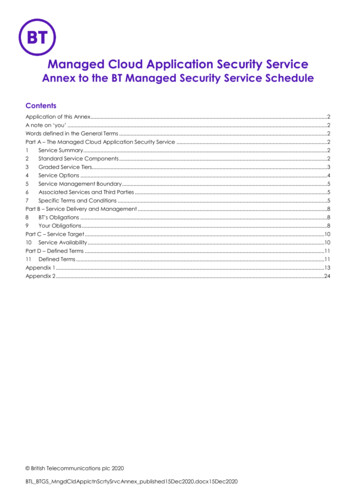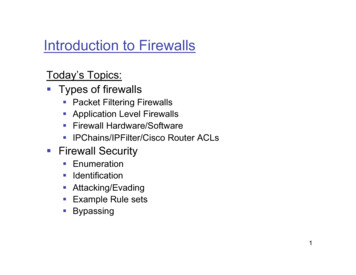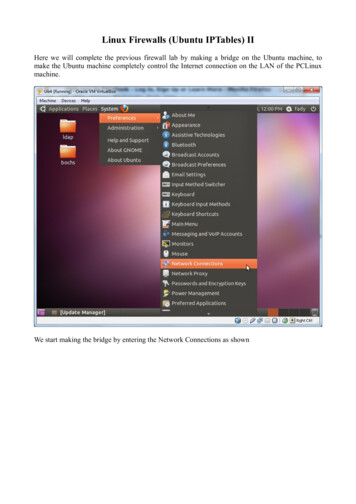
Transcription
Linux Firewalls (Ubuntu IPTables) IIHere we will complete the previous firewall lab by making a bridge on the Ubuntu machine, tomake the Ubuntu machine completely control the Internet connection on the LAN of the PCLinuxmachine.We start making the bridge by entering the Network Connections as shown
Then we just make the NIC of the local network share the connection with other computers asshown.
So the IP of the bridge NIC will be changed as shown.
Now we go to the PCLinux machine to change its IP to be on the same network of the bridgeconnection at the Ubuntu machine.
Here we note that the default gateway is the IP of the bridge connection on the Ubuntu machine andthe IP is any IP in this network.
We have now to restart the network service on the PCLinux to activate the IP change as shown.
Now Al7amd llLAH we have Internet on the PCLinux machine.
Now if we see the rules of the filter table, we will note that a lot of rules have been added, it isadded due to the bridge we make.Here also we insert the rule sudo iptables -I FORWARD 1-p tcp –dport 80 -j DROPat the first place of the FORWARD chain as we use -I and 1.
So when we see the rules again, this rule appears in the first place as shown.
This rule will prevent the PCLinux to get to the Internet again.
If we want to delete this rule, we can use the command sudo iptables -D FORWARD 1So when we see the rules again we do not see this rule.
After deleting the rule, the Internet return back to the PCLinux again.Exercise#1Insert a firewall rule or more than rule to prevent all the clients on the local network from using thefacebook.Hint: The arrange of the rules is important.
To summarize the chains of the ibtables we can use the shown .php/Quick HOWTO : Ch14 : Linux FirewallsUsing tTransformationChain in QueuePacket filtering FORWARDNetworkAddressTranslationTCP headermodificationChain FunctionFilters packets to servers accessible by anotherNIC on the firewall.INPUTFilters packets destined to the firewall.OUTPUTFilters packets originating from the firewall.PREROUTINGAddress translation occurs before routing.Facilitates the transformation of the destinationIP address to be compatible with the firewall'srouting table. Used with NAT of the destinationIP address, also known as destination NAT orDNAT.POSTROUTINGAddress translation occurs after routing. Thisimplies that there was no need to modify thedestination IP address of the packet as in prerouting. Used with NAT of the source IP addressusing either one-to-one or many-to-one NAT.This is known as source NAT, or SNAT.OUTPUTNetwork address translation for packetsgenerated by the dification of the TCP packet quality ofservice bits before routing occurs.
Custom Chains (User-Defined dvanced/One powerful feature of iptables is the ability for the user to create new chains, in addition tothe built-in ones. By convention, user-defined chains are lower-case to distinguish them. When apacket matches a rule whose target is a user-defined chain, the packet begins traversing the rules inthat user-defined chain. If that chain doesn't decide the fate of the packet, then once traversal on thatchain has finished, traversal resumes on the next rule in the current chain.Custom chains can be specified as a target to jump to. For example, you could create a socalled whitelist for trusted IP address, and a blacklist for evil nodes on the Internet. To create thechains, you would give the following commands:iptables -N whitelistiptables -N blacklistTo add a rule to these chains (or any other chain), use:iptables -A whitelist -s 192.168.0.0/24 -j ACCEPTiptables -A blacklist -s 207.46.130.0/24 -j DROPiptables -A blacklist -s 207.46.250.0/24 -j DROPThen, specify these chains as a target in your INPUT, FORWARD and/or OUTPUT bles-A-A-A-A-A-AINPUT -j whitelistINPUT -j blacklistOUTPUT -j whitelistOUTPUT -j blacklistFORWARD -j whitelistFORWARD -j blacklistUser-Defined Chains don't have any default policies.
Accepting or denying connections to the advanced/Let’s suppose you have a mail server directly connected to the Internet (ergo, no modem orrouter), and you want the machine to be completely secure, at least as far as the firewall isconcerned. A mail server where mail is delivered typically uses port 25 (SMTP), and mail serversused by users to read their mail typically use port 110 (POP) and 143 (IMAP). Assuming you have aremote console, the firewall does not necessarily need to allow connections to port 22 (SSH). Wealso assume no mail has to be send via this mail server. So, connections from anywhere to your mailserver’s port 25, 110 and 143 should be allowed by the firewall.The commands we use can be saved in a file with extesion *.sh ( as a script), then we justrun this script by the command sudo sh filename.sh. The first line tells the kernel which shell touse to run this script by specifing its path.#!/bin/bash#Load the connection tracker kernel module which enables iptables to tracke the#connections by caching the related information and examining its status.#kernel module is like MS windows driver.modprobe ip conntrack#Set theiptablesiptablesiptablesdefault target to DROP of all chains involved here.-P INPUT DROP-P FORWARD DROP-P OUTPUT DROP#Accept from the loopback as input and Output interfaceiptables -A INPUT -i lo -j ACCEPTiptables -A OUTPUT -o lo -j ACCEPT#DROP if the SYN flag is not set and match by state only the new connections.iptables -A INPUT -p tcp ! --syn -m state --state NEW -j DROP#Allow the traffic from a known IP on the whitelist chainiptables -N whitelistiptables -A whitelist -s 1.2.3.4 -j ACCEPT#Drop the traffic from private IPs and a known spammer on the blacklist chain.iptables -N blacklistiptables -A blacklist -s 10.0.0.0/8 -j DROPiptables -A blacklist -s 172.16.0.0/12 -j DROPiptables -A blacklist -s 169.254.0.0/16 -j DROPiptables -A blacklist -s 192.168.0.0/16 -j DROPiptables -A blacklist -s spammer.com -j DROP#Get ouriptablesiptablesiptablesiptableswhitelist and blacklist into place-A INPUT -j whitelist-A INPUT -j blacklist-A OUTPUT -j whitelist-A OUTPUT -j blacklist# Allow newiptables -Aiptables -Aiptables -Aiptables -Aiptables -Aiptables -ASMTP, POP, and IMAP connectionsINPUT -p tcp --dport 25 -m state --state NEW,ESTABLISHED -j ACCEPTOUTPUT -p tcp --sport 25 -m state --state ESTABLISHED -j ACCEPTINPUT -p tcp --dport 110 -m state --state NEW,ESTABLISHED -j ACCEPTOUTPUT -p tcp --sport 110 -m state --state ESTABLISHED -j ACCEPTINPUT -p tcp --dport 143 -m state --state NEW,ESTABLISHED -j ACCEPTOUTPUT -p tcp --sport 143 -m state --state ESTABLISHED -j ACCEPT
Linux Firewalls (Ubuntu IPTables) II Here we will complete the previous firewall lab by making a bridge on the Ubuntu machine, to make the Ubuntu machine completely control the Internet connection on the LAN of the PCLinux machine. We start making the bridge by entering the Network Connections as shown.
